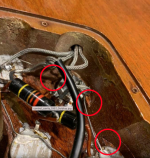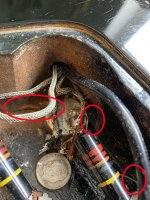LyleGorch
Active member
- Joined
- Aug 17, 2018
- Messages
- 182
So where are we on this? Does MarkknopflerisGod own this guitar? Real or fake? I gotta headache.
Cavity
Here is the cavity of 7 7322. The wire channel is exactly, like on the discussed guitar, also same as like on the other all mahogany I posted before. The only difference is that one of the cavity wall is straight and not rounded. However also that has bee discussed before, not only by me, but also other members. Photos with all rounded walls have been provided.
So claims, that this is all wrong are not correct.
Burst [and Goldtop] cavities...AVH question.
While looking through Burst gang the other day, I noticed these cavity shots of 9-2174, on page 144. Have any of you seen other LPs with this outline? The oddities are, there are no straight line cuts between the neck volume and neck tone pots, nor between the two volume pots. I did a brief...www.lespaulforum.com


The chew mark exists because it is cut with a spotface/counterbore as a separate step from the angled portion of the cavity floor that squares the two inner lobes of the cloverleaf. The chew mark is not made by a drill chuckView attachment 15064
^^ That pic looks more like the chew I'd expect to see, I'll admit.
But, as sws1 wrote: "I don't understand why there would be a chew mark on the guitar in question, if there isn't any visible routing on the bottom of the cavity for the pots"
is still a good point.